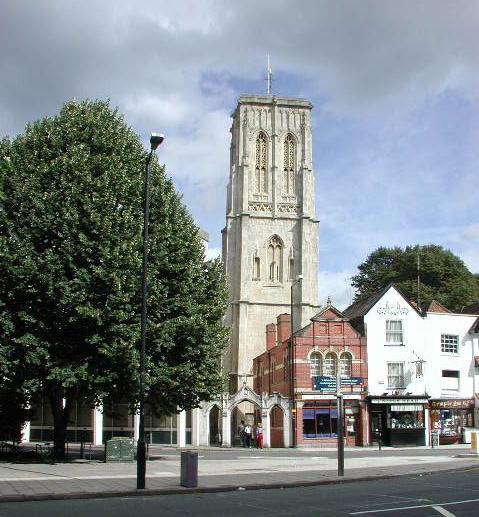 |
Holy Cross (Temple Church) CITY Bristol |
One of Bristol's best kept secrets, a secret which almost became a disaster. The parish church of Holy Cross stands overlooking Victoria Street in what was really the first suburb of the old City of Bristol. It lies to the south of the River Avon, the old city having grown up to the north of Bristol Bridge, the reason for the city's existance. It is however rarely known by its dedication, but as Temple church, because it was built on the site of the oval church of the Knight's Templars, suppressed in the early part of the C14. The choir and chapels are C14 Decorated in style, the nave and aisles are early Perpendicular work of late C14.
The famous (well, in Bristol it is famous) tower rises to 114 feet (35m) and the lowest two stages were built c1390. Work was stopped because the tower started to lean. When it appeared to stop the top stage was added in c1460 and was built in the then-vertical. If you look closely at the tower you can see the change in angle. However the weight of this extra stage increased the tower's lean again, and the tower was left incomplete without any parapet and pinnacles. The lean is popularly attributed to the foundations of the tower being built on top of woolsacks but is most likely due to the soft alluvial clay underneath being compressed.
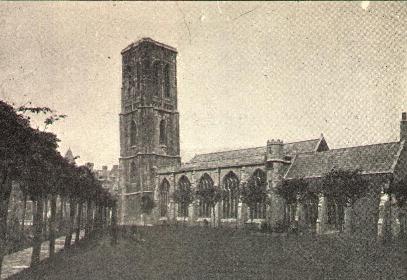
The view from the south shows the tower leaning away from its church. The large side windows of the five-bayed nave aisles can also be seen. However the church is not as it appears here today, following the destruction of the interior in the air raid of November 24th 1940. The tower, perhaps surprisingly, survived the bombs but nearly didn't survive the Sappers of the British Army who were called in to make buildings safe after any blitz. So the story goes, explosive charges had been set around the church tower when an elderly Bristolian asked what the soldiers were doing. They replied that they had to bring the tower down because of its dangerous lean. They were then surprised to hear him say "Well, it's been like that for nearly 500 years........" and this luckily saved the tower for us to marvel at today.
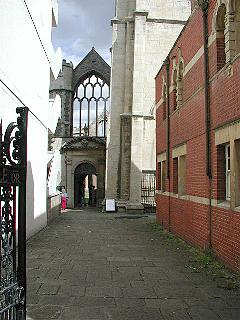 |
The entrance to the church from Victoria Street is via a small alleyway. I assure you that in the picture on the right the camera is stood upright! The tower in fact stands at the south-west corner of the church, and to the north is a small handsome early C18 porch leading into the west end of the nave. Three pretty niches adorn the west wall of the tower. After the war the bells went to the cathedral's north-west tower but the frames still remain in the tower. It must have taken some nerve to be a bell-ringer here! | 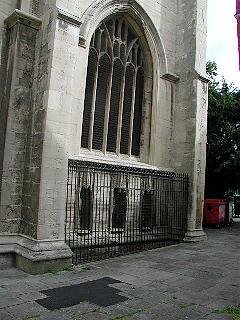 |
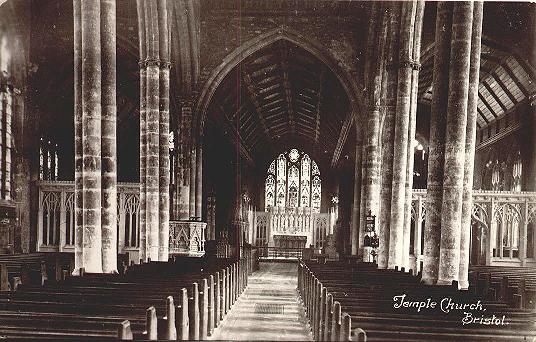
The interior of the church was quite large, with tall five-bayed arcades but no clerestory. Extra light came from a three light window over the chancel arch. The chancel was exceptionally long and had shorter side chapels. The chapel of St Katherine to the north was the chapel of the Weavers' Guild, and was still known as the Weavers' Chapel.
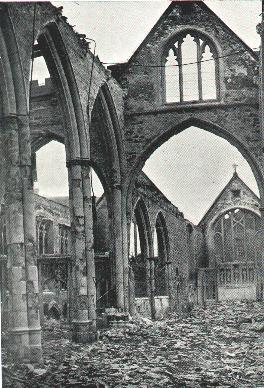 |
An idea of the devastation following the blitz can be gathered from the photograph on the left. Although much appeared to have survived the war, in fact they had not. The arcades still stood but were very unsafe and have since been removed. The stone screens to the chapels and the reredos crumbled when attempts were made to remove them for safe keeping. However the metal parclose screens to the side chapels did survive and are today in the Lord Mayor's Chapel. Amazingly too the C15 candelabrum with its central statue of the Virgin Mary also survived, a little dented, and now hangs in the Berkeley Chapel of Bristol Cathedral. (see below, right) The font as some other metal work went to the new church of Holy Cross built at Inns Court, South Bristol. This too has been demolished and replaced but the font still survives in use in the new church. (Illustration appears below) | 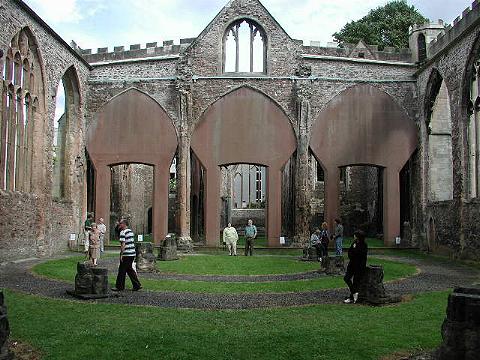 |
|
The ruins today are in the care of English Heritage and as such became the first English parish church to be taken into ownwership by the then Ministry of Works. The blitz has enabled the site to be excavated and the plan of the former Templar's church are laid out in the turf. On the left above is the interior of the Weaver's Chapel today and in the centre the interior of the chancel. A small piece of the former chancel fittings is sheltered by the roof and grille at the far left-hand end of the chancel. Sadly the ruins have had to be supported by ugly supporting pillars and walls, but rather these than collapse.
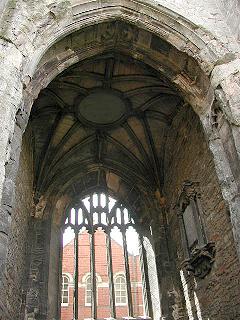 |
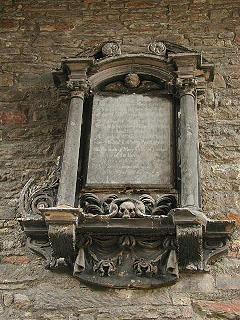 |
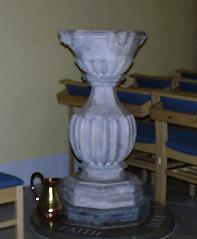 The font now at Holy Cross Church at Inns Court |
The interior of the tower preserves its bell-hole and ribbed vault. High up on the north wall a baroque wall monument survives, although the epitaph is hard to read from the ground.
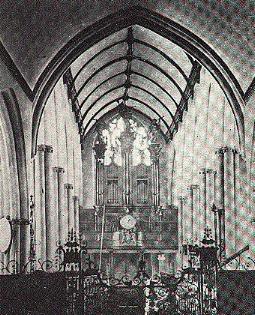 |
The picture on the left shows the pre-Victorian interior looking west. At that time there was a superb baroque organ case with trumpeting angels on top of a west gallery. There was also a large clock and Royal Arms. All this was swept away in the Victorian restoration. The view on the right was never planned to be seen, looking up at the tower from the north-east corner of the north aisle. | 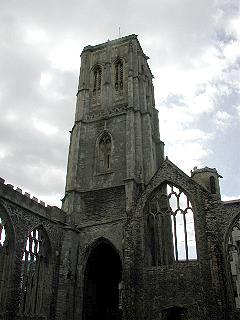 |
Matthew's Directory of 1793/4 has the following description of Temple Church:
"Temple or Holy Cross Church, thus nominated from the Knights Templars, who wore a white habit with a red cross upon the left shoulder, and by whom it was founded in the reign of King Stephen, about the year 1145. This Church seems to have been built at different times, is spacious and lofty, and after Redcliff Church the largest in Bristol. There is an elegant gilded organ on a gallery over the western door; and the long ailes, large windows and arches, lofty cieling, slender pillars and light open area, have a pleasing effect on spectators. The altar is rich, and adorned with four fine paintings, of Moses and his rod, Aaron in his robes, and Peter and Paul, in carved and gilded frames. There are several ancient brasses, inscriptions, and modern monuments in this Church which brevity obliges us to omit. It has 3 ailes, and is from East to West 159 feet, and 59 wide, the middle aile is 50 feet high. But one of the greatest curiosities of Bristol, is the leaning tower of Temple, the foundation of which has so sunk, that it is widely separated from the wall of the Church, and so impends at the south west corner as to appear ready to tumble down. It is a venerable monument of antiquity; and though so lofty as 112 feet (ending in a plain cornice, without rail, battlement or pinnacle) contains a good peal of 8 bells, which are commonly rung, and on which the quarters and hour are struck, and chimes played at 4, 8 and 12: it is said that when these are rung in full peal, if a bason full of water be put on the leads of the tower, it will soon be emptied by the vibration of this apparently precarious yet permanent structure. The best place in which to view this tower is about the middle of Church Lane, by the Church yard wall."
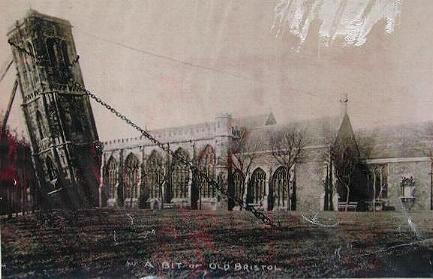
A small exhibition was set up in the west porch for open doors day 2001 (September 8th) by Tony Rees of English Heritage. It included this rather amusing postcard from his collection showing the tower held up by chains and props! I have to say this is a faked picture......but I hope you had guessed that and found it as amusing as I did.
Page created 16th September 2001